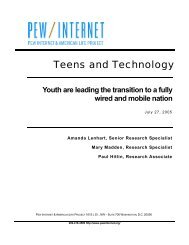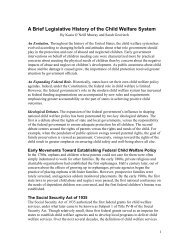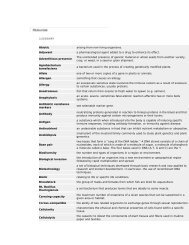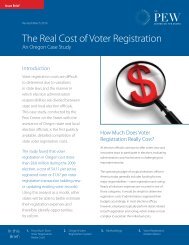Report: The State of Preschool 2008: State Preschool Yearbook
Report: The State of Preschool 2008: State Preschool Yearbook
Report: The State of Preschool 2008: State Preschool Yearbook
Create successful ePaper yourself
Turn your PDF publications into a flip-book with our unique Google optimized e-Paper software.
ARIZONA EARLY CHILDHOOD BLOCK GRANT – PREKINDERGARTEN COMPONENT<br />
ACCESS<br />
Total state program enrollment ........................................5,401<br />
School districts that <strong>of</strong>fer state program ............................17%<br />
Income requirement ..................................................185% FPL<br />
Hours <strong>of</strong> operation ......................................Determined locally 1<br />
Operating schedule ..........................................Academic year<br />
Special education enrollment ..........................................8,463<br />
Federally funded Head Start enrollment ........................17,119<br />
<strong>State</strong>-funded Head Start enrollment ......................................0<br />
QUALITY STANDARDS CHECKLIST<br />
STATE PRE-K AND HEAD START ENROLLMENT<br />
AS PERCENTAGE OF TOTAL POPULATION<br />
3-YEAR-OLDS<br />
4-YEAR-OLDS<br />
91%<br />
3%<br />
6%<br />
■ Pre-K ■ Head Start ■ Special Ed † ■ Other/None<br />
† This number represents children in special education who are not<br />
enrolled in Head Start but may be enrolled in state-funded pre-K.<br />
6%<br />
12%<br />
3%<br />
79%<br />
POLICY STATE PRE-K BENCHMARK DOES REQUIREMENT<br />
REQUIREMENT<br />
MEET BENCHMARK?<br />
Early learning standards ..................................Comprehensive ..........Comprehensive<br />
Teacher degree ..................................................................HSD 2 ..........BA<br />
Teacher specialized training..............................................None 2 ..........Specializing in pre-K<br />
Assistant teacher degree....................................................HSD 3 ..........CDA or equivalent<br />
Teacher in-service ..............................................12 clock hours ..........At least 15 hours/year<br />
Maximum class size ..............................................................................20 or lower<br />
3-year-olds ........................................................................NA<br />
4-year-olds ..........................................................................20<br />
Staff-child ratio ......................................................................................1:10 or better<br />
3-year-olds ........................................................................NA<br />
4-year-olds ......................................................................1:10<br />
Screening/referral........................................Determined locally ..........Vision, hearing, health; and<br />
and support services<br />
at least 1 support service<br />
Meals ..................................Depend on length <strong>of</strong> program day 4 ..........At least 1/day<br />
Monitoring ..............................Site visits and other monitoring ..........Site visits<br />
TOTAL<br />
BENCHMARKS<br />
MET<br />
RESOURCES<br />
Total state pre-K spending ....................................$12,507,717<br />
Local match required? ..........................................................No<br />
<strong>State</strong> spending per child enrolled ..................................$2,316<br />
All reported spending per child enrolled* ....................$2,316<br />
PRE-K*<br />
HDST<br />
SPENDING PER CHILD ENROLLED<br />
$2,316<br />
$8,727<br />
* Pre-K programs may receive additional funds from federal or local sources<br />
that are not included in this figure.<br />
** K–12 expenditures include capital spending as well as current operating<br />
expenditures.<br />
Data are for the ‘07-’08 school year, unless otherwise noted.<br />
K–12**<br />
0 2 4 6 8 10 12 14 16 18<br />
■ <strong>State</strong> Contributions<br />
■ Local Contributions<br />
$6,494<br />
$ THOUSANDS<br />
■ Federal Contributions<br />
■ TANF Spending<br />
1 Most ECBG programs operate 4 hours per day, 3-5 days per week for the<br />
academic year. It is recommended that programs operate at least 12 hours<br />
per week.<br />
2 As <strong>of</strong> July 1, 2009, all pre-K teachers in settings funded by ECBG must hold an<br />
early childhood certification, which requires a bachelor's degree. Since 2005,<br />
most programs have hired new staff who have or are eligible for the EC<br />
certification or endorsement. <strong>The</strong> Arizona Department <strong>of</strong> Education is working<br />
closely with the community colleges and universities to <strong>of</strong>fer scholarships and<br />
onsite classes to allow current teachers to work toward a BA in ECE.<br />
3 Assistant teachers must have at least a high school diploma. <strong>The</strong> exception is for<br />
assistants in Title I schools, who must have an AA per NCLB requirements.<br />
4 <strong>The</strong> state licensing agency requires licensed programs, including all ECBG pre-K<br />
programs, to provide meals depending on the length <strong>of</strong> time and the time <strong>of</strong> day<br />
a child attends. A child present at or before 8 am must be served breakfast; a<br />
child present between 11 am and 1 pm must be served lunch; and a child<br />
present at or after 5 pm must be served dinner. Children present between 2 and<br />
4 hours must be served at least one snack; if present between 4 and 8 hours, one<br />
meal and at least one snack; and if present for 9 or more hours, at least one meal<br />
and two snacks.<br />
35

















